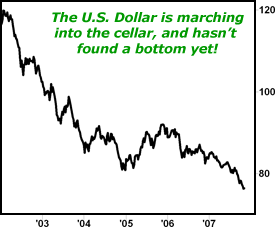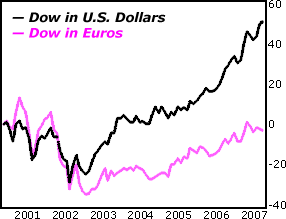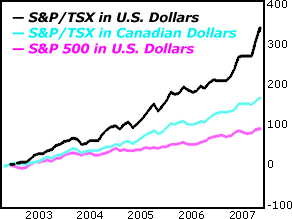US Dollar Bear Market That's Threatening Nearly Every Portfolio
Stock-Markets / US Dollar Nov 08, 2007 - 09:34 AM GMT  Sean Brodrick writes: Despite some hiccups, the broad indices have had a great run recently, pushed along by good data on jobs, personal spending and more. It's what you call a "Goldilocks market" — a time when the economic data isn't too hot and isn't too cold.
Sean Brodrick writes: Despite some hiccups, the broad indices have had a great run recently, pushed along by good data on jobs, personal spending and more. It's what you call a "Goldilocks market" — a time when the economic data isn't too hot and isn't too cold.
Gross domestic product is rising at a 3.9% clip, so investors feel things are just right, and they keep pushing stocks higher.
However, I think they're making a big mistake by ignoring many problems facing the economy. Rising foreclosures and inflation are just two examples. Exploding oil prices, which reached another all-time high yesterday, are another. And so is …
A Bear Market in the Dollar That's Threatening Nearly Every Portfolio
The common definition of a bear market is a decline of 20% or more. And through the end of last week, the U.S. dollar index, which measures the greenback against a basket of the world's currencies — was down more than 36% from its peak in 2001.
If that seems a little abstract, take 100 dollar bills out of the bank and then throw 36 of them in the trash. That's what's happened to the value of the money in your wallet over the past six years!
We've been warning you about the weakening U.S. dollar for quite some time here in Money and Markets . But I fear that the decline so far may be just a bump compared to the plunge around the corner. Why?

First, saying that our elected windbags in Washington spend money like drunken sailors is an insult to drunken sailors.
Second, runaway consumer debt ($915 BILLION in U.S. credit card debt alone!), credit inflation and the bursting real estate bubble are compounding the problem.
Third, while the U.S. economy is doing okay, it's still lagging the performances of many other countries. In fact, the International Monetary Fund has targeted global economic growth at over 5%, led by powerhouses like India and China.
Fourth, the Federal Reserve didn't help matters by cutting its Fed Funds rate another 25 basis points last week. U.S. interest rates are already lower than in some other leading countries such as Canada. Higher interest rates overseas attract even more money out of dollar-denominated investments!
All of these forces are conspiring to push the greenback lower and lower. The consequences are not just bad for those of us who get paid in dollars; they're equally bad for foreign investors who have their portfolios invested in U.S. assets.
Just look at the chart I made. It shows the Dow Jones Industrial Average's performance in both U.S. dollars and euros. As you can see from the black line, the Dow has risen 29% since 2001, and it's racked up a 49.4% total return (the black line).

But measured in euros, over the same timeframe, the Dow is actually down 16% in price for a total return of MINUS 2.9% (the pink line).
In other words, European investors actually lost money in U.S. stocks over the last six years!
In fact, when they convert their investment back into euros, they've underperformed by more than 52 percentage points!
Maybe this is why foreign investors sold a net $70 billion in U.S. securities in August, according to the U.S. Treasury. That was the biggest outflow since 1990!
Clearly, people overseas are starting to realize there's not much anyone can do to stop the dollar from falling further. After all, if the Fed hikes interest rates, that's going to slow down economic growth, which will also weigh on the U.S. dollar. Talk about being caught between a rock and a hard place!
For all these reasons, I think you should also consider taking steps to protect yourself from a further decline in the greenback …
Three Ways to Cushion Your Portfolio Against a Grizzly Dollar Bear
I don't think you should wait around to see whether the dollar bounces or not. The risk is just too great. So, here are three ways you can help insulate your portfolio from additional downside in the greenback …
#1. Gold: Sure, gold looks high at more than $800 an ounce. But it's going to look even higher when it hits $900!
Remember, as the U.S. dollar goes lower, gold is almost surely going to move up. I find the best way to explain the relationship between gold and the dollar is "a see-saw of pain." One goes up, while the other gets hurt.
#2. Other Commodities: Grains, industrial metals, natural gas, crude oil, nickel — these are all going higher as developing nations shift into overdrive. Unlike gold, these other commodities don't sit in a vault — they get used up and pinches along the supply line can make them even more volatile than the yellow metal. Just take a look at oil prices, which hit another record high yesterday!
#3. Foreign Stocks: Foreign stocks, because they are denominated in currencies other than the U.S. dollar, protect you against a falling greenback. And thanks to tracking stocks on the U.S. pink sheets and American Depositary Receipts of foreign stocks, they're pretty easy to buy.
And owning foreign stocks, especially those that are also connected to natural resources, is a great way to not only protect yourself, but also to get outsized returns. Let me show you what I mean …
Recently, subscribers to my Red-Hot Canadian Small-Caps service booked gains on two different foreign mining companies — Aurizon Mines and Jaguar Mining.
Aurizon didn't take very long to pan out. If they bought the shares on a Canadian exchange, they booked a tidy gain of 10.9%. And if they bought the AMEX-listed shares, they racked up an even bigger profit of 23.6% thanks to the currency differential caused by a declining greenback.
Jaguar is a longer-term hold — so I told my subscribers to take half profits. On the Canadian shares, subscribers should have banked a profit of 55%. Meanwhile, on the company's shares on the AMEX, thanks to the declining dollar, they banked up to 90.1% gains ! And they're still holding the other half of that position for potentially more gains.
Of course, each person's individual gains depend on exactly where they got in and out, and my figures don't include commissions. But I think you can see the trend — foreign stocks can give U.S. investors a major boost when the dollar falls.

The effect isn't just limited to a few individual companies, either. Just look at this chart of the S&P/TSX 60 — a leading Canadian index — against the S&P 500. Over the past five years, the S&P 500 has racked up a total return of 91.4% … not bad.
But over the same time, the S&P/TSX 60 has racked up a total return of 166.3%. And if you take those Canadian stocks and translate them back into U.S. dollars, you would have gotten a total return of 337.5%! Wow!
Want a mutual fund that combines gold, other commodities, and foreign stocks into one package? Then check out the U.S. Global Investors Global Resources Fund (PSPFX) . It's more focused on energy right now, but it does own gold miners and the fund has the leeway to invest in whatever it thinks will be hot.
Or, if you have more appetite for risk, consider the kind of foreign small-cap natural resource stocks I recommend in Red-Hot Canadian Small-Caps . You have to do your own due diligence and be prepared for a wild ride, but as I just showed you, these stocks have the potential to really supercharge your portfolio's performance.
Yours for trading profits,
Sean
This investment news is brought to you by Money and Markets . Money and Markets is a free daily investment newsletter from Martin D. Weiss and Weiss Research analysts offering the latest investing news and financial insights for the stock market, including tips and advice on investing in gold, energy and oil. Dr. Weiss is a leader in the fields of investing, interest rates, financial safety and economic forecasting. To view archives or subscribe, visit http://www.moneyandmarkets.com .
Money and Markets Archive |
© 2005-2022 http://www.MarketOracle.co.uk - The Market Oracle is a FREE Daily Financial Markets Analysis & Forecasting online publication.



